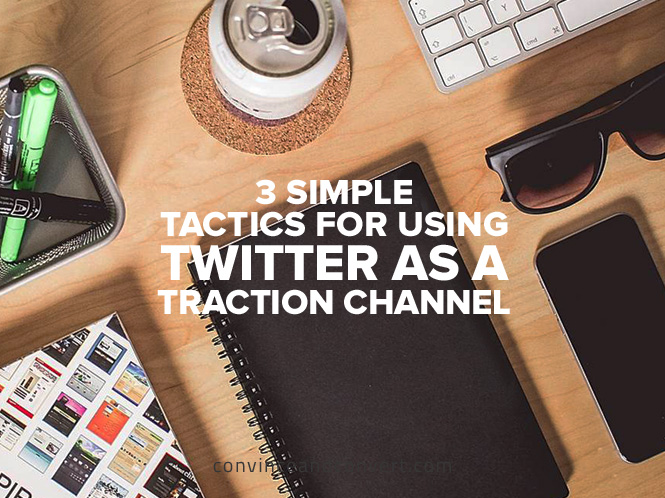
Wondering if Twitter could be the marketing tool your business needs? Thinking your company needs a larger Twitter following? Here are the questions you should ask yourself first:
- Do I need business instantly (and have no following)? If yes, then no social media channel is going to be right for you—try advertising.
- Do I (or my team) have four hours a week and $100 a month (that’s your estimated tool cost)? If no, then you won’t be able to actually pull this off.
- Do I know who my ideal customer is (especially what hashtags they might use to identify themselves)? If no, then figure out your buyer persona before attempting this strategy.
- Do I have tracking set up on my website (email conversions, most importantly)? This is standard operating procedure, so it better be a “yes.”
- Do I have blog content or something valuable to promote? If no, then create that before beginning.
Now, if you’re ready to proceed, Twitter marketing could be just what you were looking for. But before we begin, I have to tell you the truth about marketing on Twitter…
The Truth About Twitter Marketing
Twitter is a vain site, with tons of spammers, black hatters, and fake accounts. Even the real people on Twitter are too busy for you. Most are getting 100 new Tweets in their feed every second. This bombardment of information is happening all across social media, and at this point, it’s just part of playing the game.
No one is on social media to download your stupid e-book. Engagement > Promotion.
Remember: You’re on Twitter, and the people seeing your posts aren’t on your site and don’t give a crap about you. In fact, they almost certainly aren’t thinking about you at all, and they might not even know who you (or your company) are. I’m saying this not to scare you, but to set the stage for your Twitter digital marketing strategy.
The word “value” is thrown around a lot these days. If you aren’t operating your Twitter digital marketing strategy from a place of providing value (most companies I would say operate from a place of expecting sales), then you aren’t going to perform well.
Even with all the noise out there, you can cut through it with a very simple Twitter digital marketing strategy that involves three simple tactics.
1. Increase Engagement and Growth by Sending Auto-Mentions to New Followers
Auto-mentions on Twitter have changed my life. It’s true—I have new business partners and tons of business connections because of the auto-mention.
The only way I know to use auto-mentions effectively is with my favorite Twitter marketing tool, Audiense. I highly recommend checking it out this awesome tool for Twitter marketing and growth, but if you have your own way, that’s fine too.
Here’s how auto-mentions works:
1. Someone follows you.
2. This triggers an automatic Tweet at them.
You don’t DM (direct message) them some spammy message, and you certainly don’t Tweet some spammy message. Remember the rule: Provide value!
What’s the best way to do that? Ask a question!
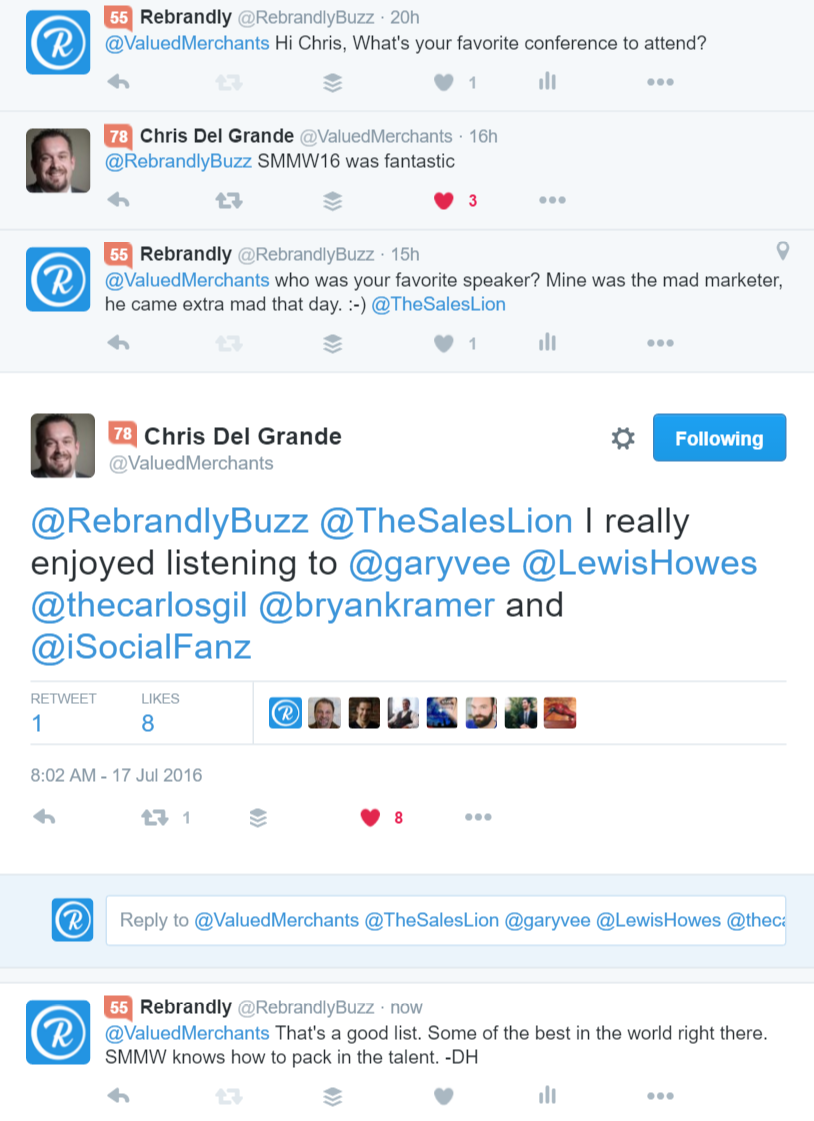
Here, we asked Chris what his favorite conference to attend was. He responded “Social Media Marketing World 2016,” which I also happened to have attended (and it’s also my favorite). I bring my favorite speaker, Marcus Sheridan, into the conversation, and all of a sudden he’s shouting out to Gary Vee and the whole gang.
The second best thing to do is send them to the best, most relevant blog post you’ve ever written in your life. It’s your one chance to impress someone—better send them to the goods!
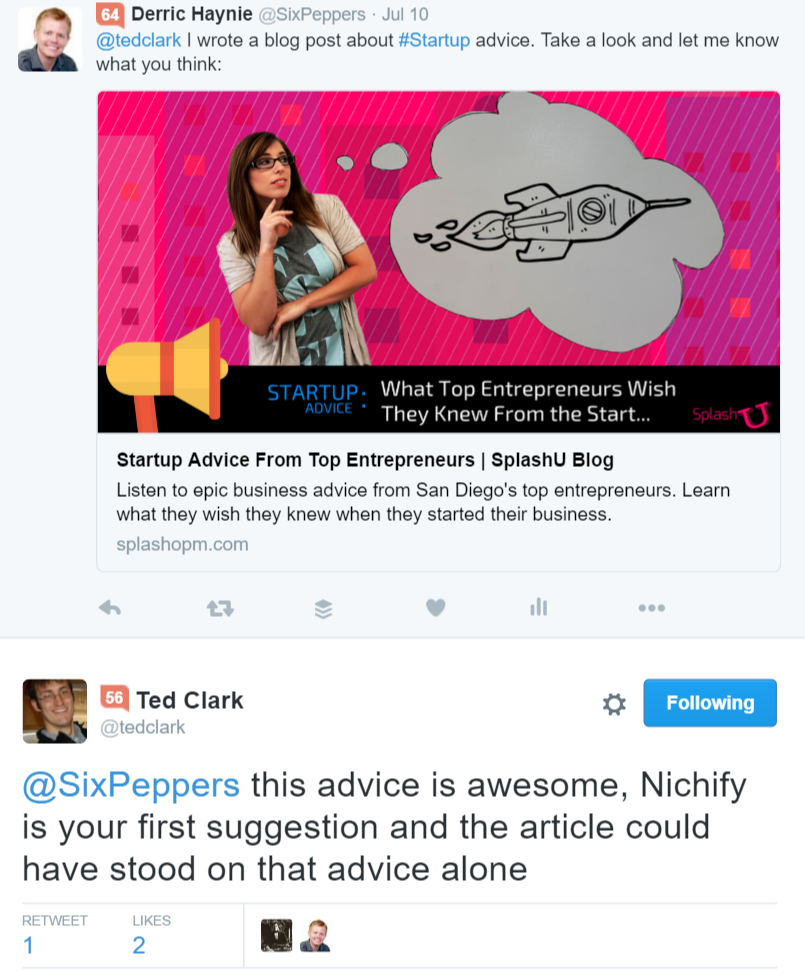
But the key here is targeting. With Audiense, you can detect keywords in a user’s bio to send them the right kind of content. I only send this blog post (called “Startup Advice”) to people that have “#Startup” in their bio. Make sense?
3. People respond and engage.
People don’t respond to DMs because they are private and mostly spam. But people love responding to mentions because it’s the nature of Twitter, to respond and engage with people in a public setting for short conversations. And this isn’t some sort of trick—we really do want to chat with people, but can’t possibly start a conversation with everyone manually.
4. You continue the conversation (when appropriate).
Congratulations, you’ve just started a conversation on social media. Not that innovative, and not that hard. Yet no one is doing this!
Do Auto-Mentions Actually Work?
Every single time. I’ve validated across multiple brands and accounts. Account growth goes up substantially:
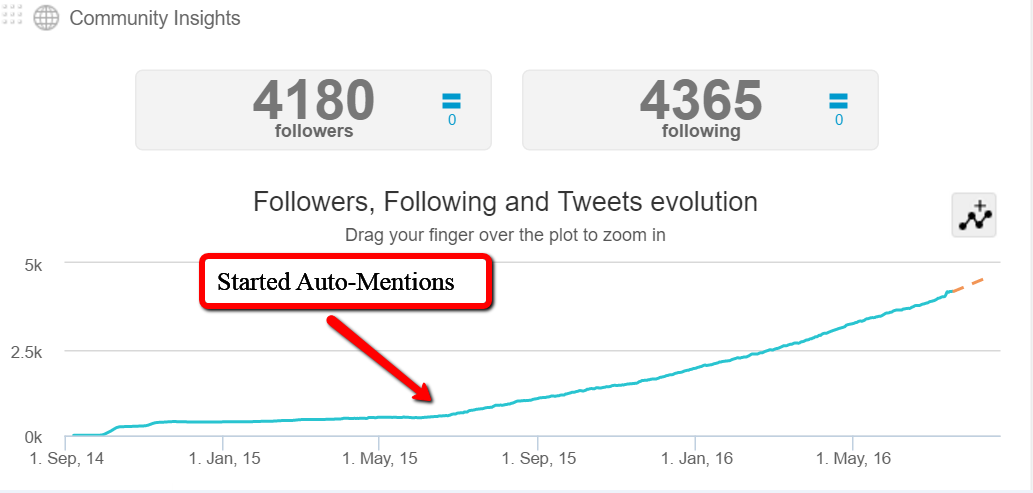
And so does engagement:
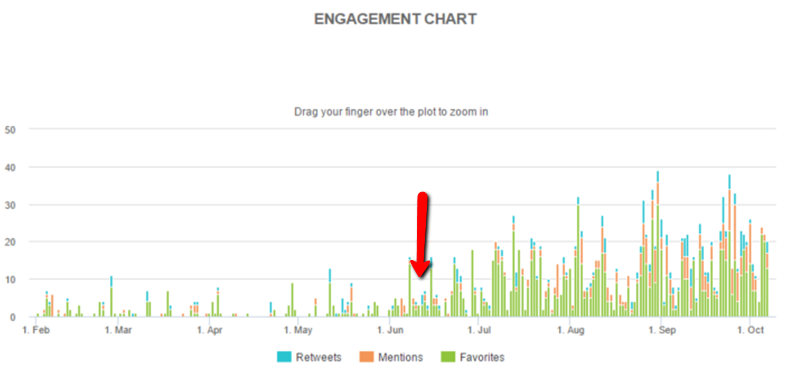
The 3 Rules of Auto-Mentions
- Only point people to things that are completely free and ungated.
- Respond to every response.
- Only use this strategy when people follow you.
The Most Common Misconception About Auto-Mentions
The common misconception is that this tactic is spammy. Every one in 1,000 auto-mentions I get someone responding (hey, still starting a conversation) telling me they don’t appreciate my spammy message.
But it isn’t spammy. Social automation can be used for good as well as evil, so it really matters who’s controlling the rocket ship. An auto-mention sending people to some random squeeze page for an e-book they aren’t going to read is spammy. An auto-mention asking someone their favorite speaker? Favorite book? That’s a conversation starter.
People use these conversation starters every single day at parties and events. This strategy is really only as automated as your canned opening line when you shake someone’s hand.
Here’s a bonus reason why auto-mentions are awesome: Mentions do not show up under your main account feed. They are in “Tweets and Replies:”
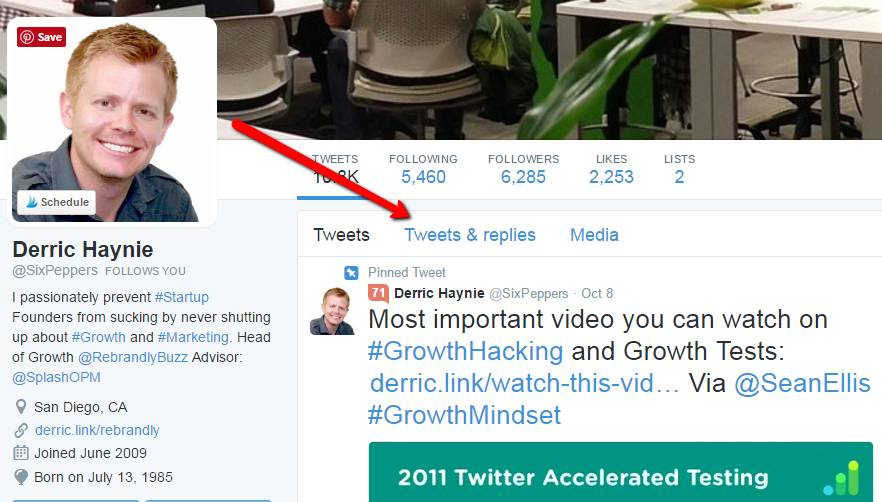
People will not see every single message you send out using this method. Thus, while the conversations are public, they are also targeted to the people that follow both you and the other account.
2. Follow New Users in Your Target Market
Yeah, I said it. Follow them! Brilliant, I know. But getting the attention of a potential user, customer, or influencer, could actually be as simple as following them.
People see their new followers in their notification feed, and they’ll frequently check out your Twitter bio and follow back. Using Twitter search or Audiense, find people fitting your target market criteria and follow 300–400 every couple of days.
Pro tip: If you use Audiense you can sort out people that don’t have avatars, people that haven’t been active in the last 15 days, and people that have new accounts. Those are all low quality followers that you don’t want to waste your time on.
Remember when I said I only send my blog post to people with “#Startup” in their bio? I also follow a lot of people with “#Startup” in their bio. See how this follow/unfollow strategy now leads right into auto-mentions? Get your auto-mentions setup, then start following the crap out of people.
There’s nothing much to this strategy other than choosing the right follow criteria. Below, we are targeting people that use “#SocialMedia” and also have a large following:
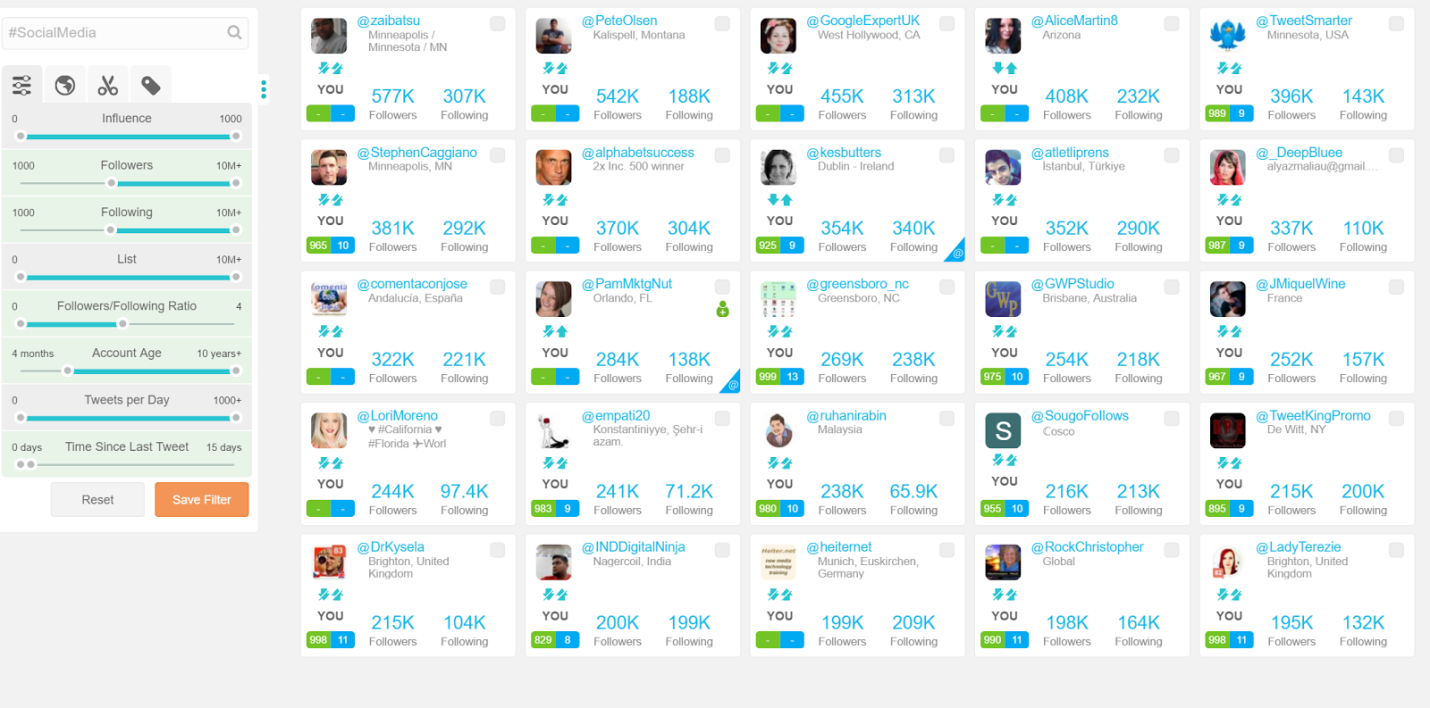
Always start with your most influential users first, so that there’s an amplification opportunity for your efforts. After a few days, you can then unfollow anyone who hasn’t followed you back. This is super helpful within Audiense, but there’s also a free tool called Mass Unfollow that, well, mass unfollows everyone not following you.
3. Content Curation Is Now Mandatory for Every Business
It blows my mind that companies, big and small, think they can act like they are the only company in the world. “Me. Me. Me. I only Tweet about me!”
The idea behind content curation is simple: Provide value to your followers by connecting them with relevant content that falls slightly outside of your area of expertise or your industry.
And here’s why it’s important: Because people don’t stop existing after they are done doing business with you.
Stop pretending your customers stop existing after they are done doing business with you.
– Derric Haynie
Here’s how you can go about curating content on Twitter:
Step 1
Go about your day online, and when you find something you think would be relevant to your audience—something that is evergreen and high quality—use Pocket or Flipboard to save it for later.
Step 2
Get MeetEdgar. It may cost you money, but it’s worth it. Log in and create a content calendar like this one:
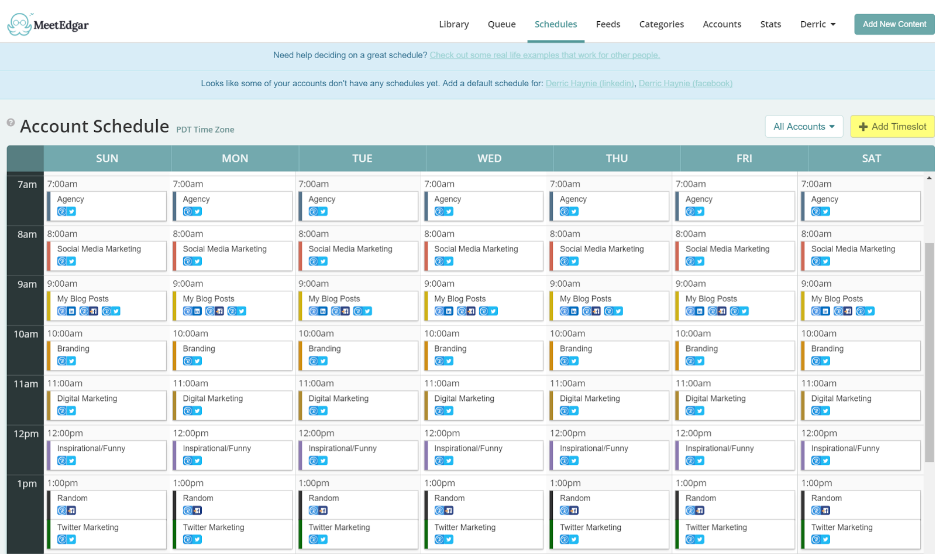
Step 3
Start adding all this relevant content to categories. This includes adding your past blog posts into their own category—it is, after all, okay to promote your own great content on your own social profile.
From here, your content will go out on an ongoing basis, filling in the gaps of your existing social media strategy. You should still, of course, find and Tweet out relevant and timely material using another tool like Buffer or Hootsuite.
MeetEdgar goes above and beyond by making you more active. (By the way, account growth is directly related to Tweet frequency.) If you want to grow, you need to Tweet. But you also can’t Tweet out crap, so you really have to work hard to find the goods.
[contextly_auto_sidebar]
Bonus: Use Branded Links to Get 34 Percent More Clicks
Instead of using a generic URL shortener, like Bitly, you can easily replace all of your links with a branded URL shortener through Rebrandly. This means you can use “mybrand.xyz” instead of “tiny.crap/random-gibberish” or the more commonly seen “bit.ly/u5Etz.”
Which Tweet do you think better represents Social Media Examiner’s brand and the link they are sharing?
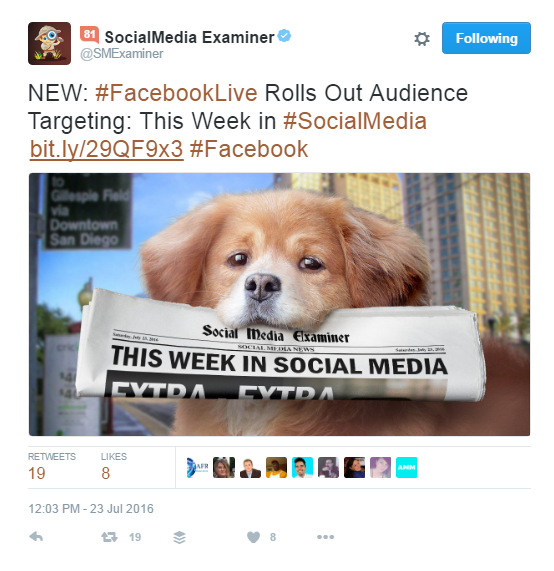
Or:

Plugging in your own URL shortener is free (you may have to purchase a domain for $2–$12) and instantly amplifies all of your marketing efforts. So why aren’t you doing it? I highly recommend always using a branded domain with a custom URL slug.
If you set aside four hours of your time each week, spread out across all five weekdays, to execute on this strategy, I guarantee you will see real growth and engagement coming into your Twitter account. There are tons of people out there on Twitter just looking to chat, hang out, or learn something new from you. Get out there, and provide them some value!
Remember that these tactics are just the beginning for companies like yours to start gaining traction. There are still tons of other things you can do on Twitter, such as influencer outreach, engaging in Twitter chats, competitive social monitoring, and creating cool and engaging video responses.
What do you think? Still not convinced auto-mentions are for you? Hesitant to follow new users for one reason or another? I’d love to hear your thoughts in the comments below.
Get more content like this, plus the very BEST marketing education, totally free. Get our Definitive email newsletter.

